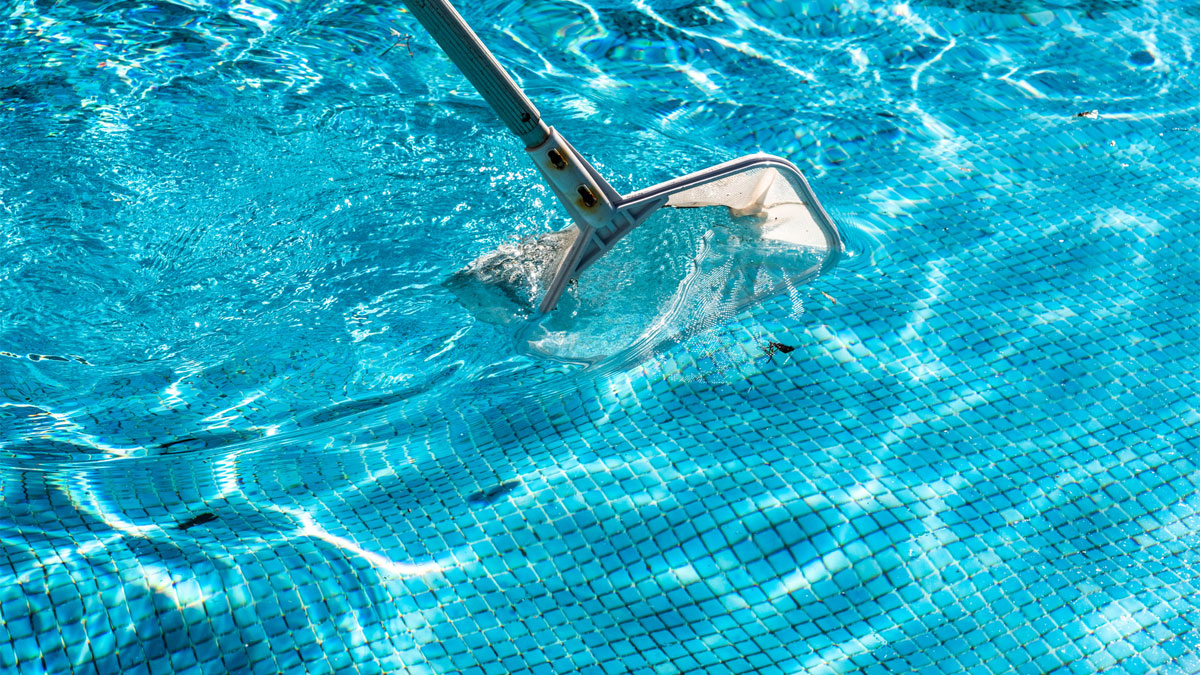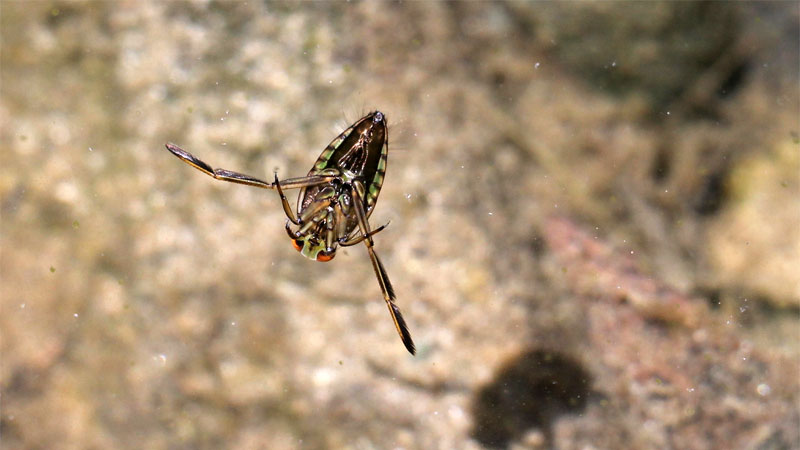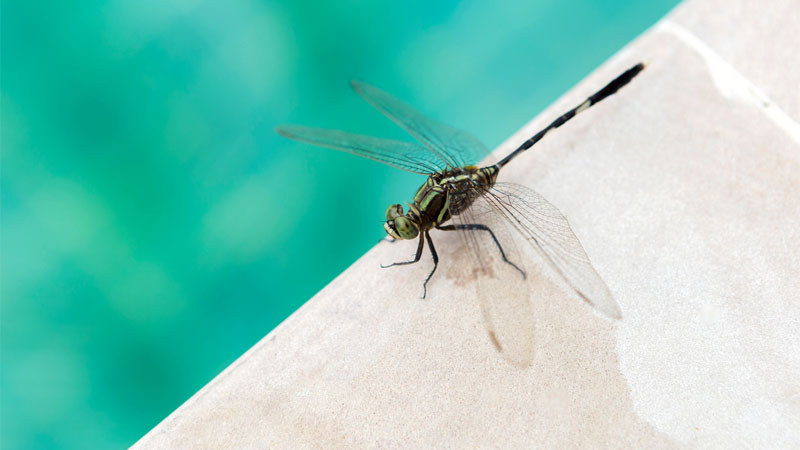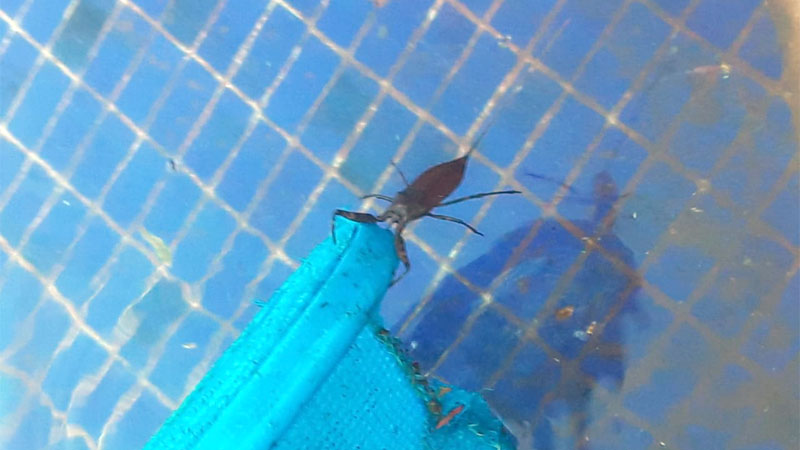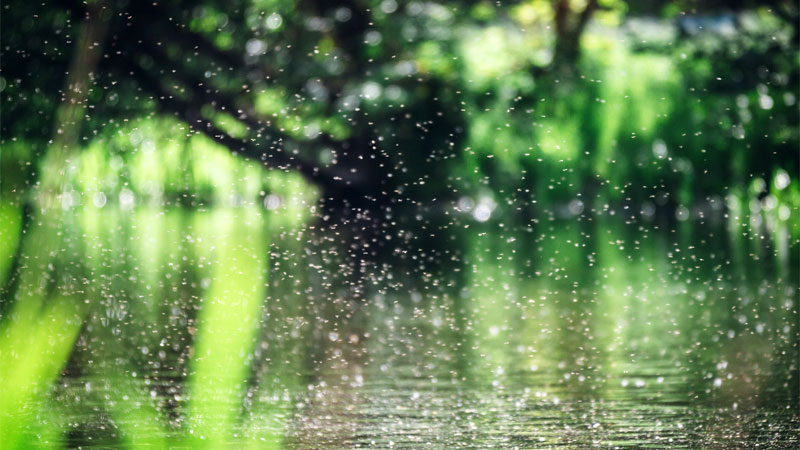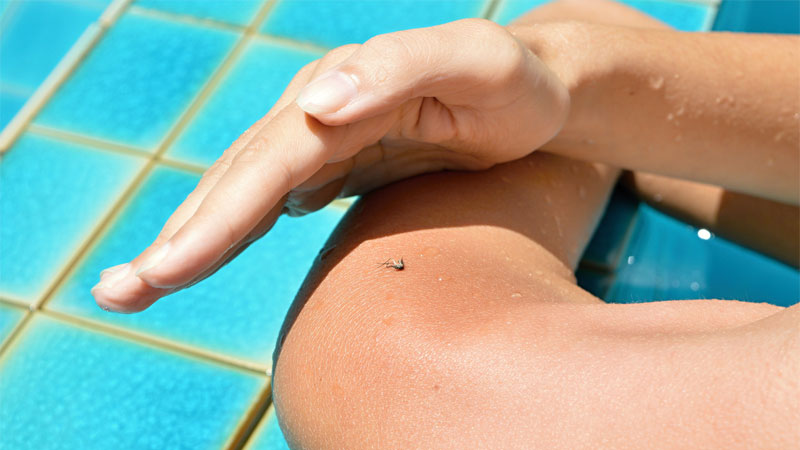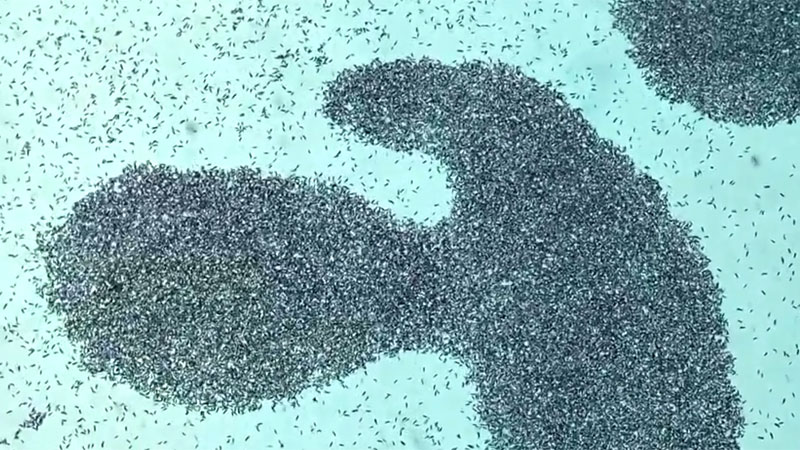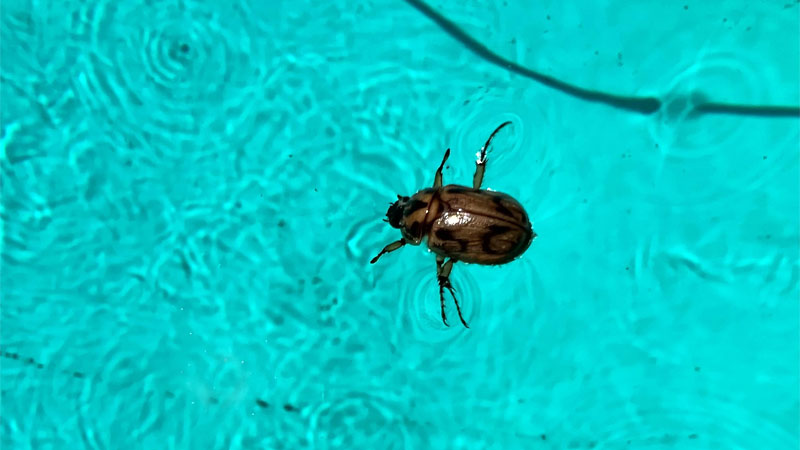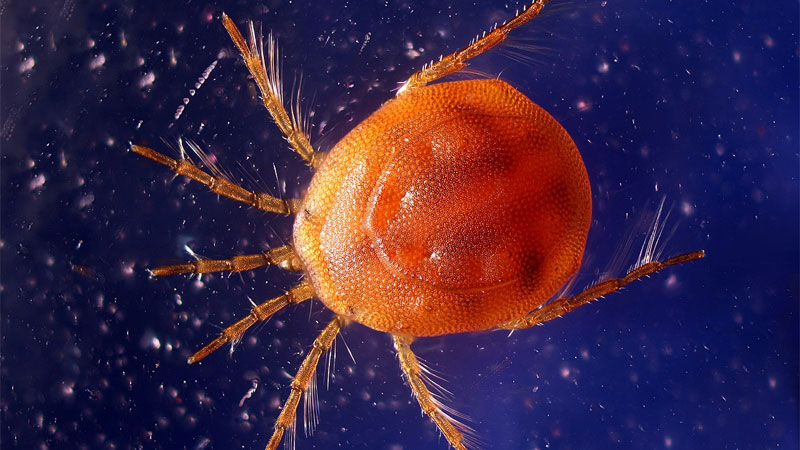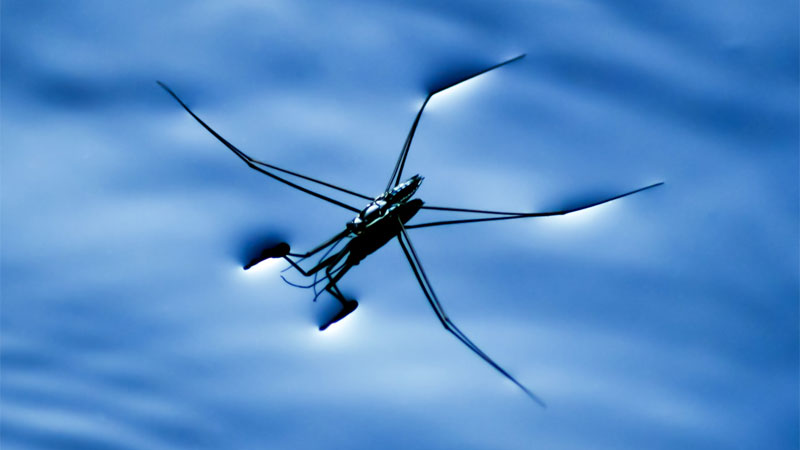It never fails. You find out it’s going to be a wonderful, hot day and decide to go swimming. You struggle to hold your excitement as you get ready and rush out to the pool, mentally drooling over the idea of that nice cool water. But right before jumping in, you stop and look in horror, as you find the surface of the water littered with bugs.
Now, we could sit here and talk about pool covers or chlorine treatments, as well as a number of other things that sometimes (but not always) help. However, it’s more important to know a little bit about the bugs that can end up in your pool and whether or not they pose a health risk.
That said, here are 11 different types of swimming pool bugs you may encounter.
See Also: How to Get Rid of Frogs In a Pool
Types of Swimming Pool Bugs
#1 – Backswimmers (Family Notonectidae)
Measuring between 0.2 and 0.6 inches long, backswimmers are a very curious family of bugs that look very similar to another type of common pool bug, the water boatman. However, they have one very strange habit that gives them their name.
To hunt their prey, a backswimmer will lay on its back in the water and use its long, fringed hind legs like oars, propelling itself along the water.
Backswimmers will hunt all sorts of insects, including the water boatman, but can also attack much larger prey including tadpoles and small fish.
They’re also known to “bite” humans they come in contact with, stabbing the victim’s skin with their sharp proboscis painfully. For this reason, if no other, you probably don’t want these little guys sharing your pool.
#2 – Dragonflies (Infraorder Anisoptera)
These attractive and beneficial insects may grace your pool with their presence. They actively hunt other insects, so while they’re fun to watch, they might be an indicator of larger problems.
#3 – Giant Water Bugs (Belostomatidae)
Of the 170 species out there, most giant water bugs aren’t actually that giant, measuring around 0.8 inches long. However, there are species as small as .35 inches and as massive as 4.5 inches long!
Adults can’t actually breathe underwater, so they’ve evolved a retractable breathing tube in their abdomen they use as a snorkel. They hunt a wide range of prey, including amphibians, fish, snails, and even baby turtles or snakes.
When hunting, these water bugs use their hooked hind legs to hang onto underwater objects, quietly awaiting any prey that wanders too close. Their front legs are modified into raptor-like claws which they use to grab onto prey, holding it in place as they stab it with their proboscis and inject a liquifying saliva.
While the saliva isn’t harmful to humans, the habit of giant water bugs playing dead if a large predator comes near can often lead to a very nasty bite. These bites have given them such colorful nicknames as alligator flea and toe biter.
Related: How to Get Rid of Water Bugs
#4 – Gnats (Suborder Nematocera)
Gnats are closely related to both midges and mosquitoes, and can be quite the nuisance. These tiny flies have a name with no distinct meaning. In other words, there is nothing that truly makes a gnat a gnat. However, scientists generally consider gnats to be any species of non-biting fly.
Gnat larvae tend to feed on plant matter, while the adults live only long enough to mate. Unfortunately, it’s this mating flight that makes gnats so unbearable.
Often forming towards dusk, the gnats will gather into large swarms that always seem to congregate right where you’re walking or swimming. They aren’t harmful, but that doesn’t mean much when they’re all around you bumping into your skin and hair.
#5 – Mosquitoes (Subfamilies Anophelinae and Culicinae)
You probably knew we would have to cover this one at some point. Mosquitoes are notorious bloodsuckers, although blood isn’t actually their main food. Instead, adult mosquitoes are actually pollinators that drink nectar.
Where they get their well-earned reputation is the need of females for a blood meal to properly create and lay her eggs. These eggs are usually placed on or just above the water’s surface and mosquito larvae tend to be aquatic.
Of course, mosquitoes are notorious for being both annoying and potentially dangerous. Different mosquito species can carry different diseases, so finding a mosquito in or near your pool may or may not mean you were exposed to a specific disease.
A few of the more prominent diseases a mosquito may be carrying include:
- Chikungunya, dengue fever, and yellow fever (mostly transmitted by Aedes aegypti)
- Heartworm disease (transmitted by various mosquitoes and can be a potentially deadly parasitic infection in dogs)
- Malaria (from the genus Anopheles)
- St. Louis Encephalitis (mainly transmitted by Culex pipiens)
Related: 14 Bugs That Are Often Mistaken for Mosquitoes
#6 – Springtails (Order Collembola)
These curious bugs were one of three groups that used to be considered insects but are now their own separate order (or sometimes class, depending on which part of the debate you prefer). Most are only around 1/4 inches long.
However, they get their name from the tail-like appendage called a furcula, which is found on most species. This furcula is normally tucked under the body and held in place much like a mousetrap. When triggered, the tail violently snaps outwards, propelling the springtail into the air.
These little bugs prefer moist areas, and often invade homes where they’ll set up shop in bathrooms or damp basements. For them, your pool is something of a paradise, and they can quickly become an infestation if you don’t properly treat your pool.
While not particularly dangerous to humans, their tiny hairs can cause skin irritation and they can become potential plant pests if you have a garden nearby.
#7 – Thrips (Order Thysanoptera)
With approximately 6,000 species out there, these tiny insects are more infamous for their habit of infesting plants than pools. However, they’re terrible flyers and often end up in the pool, often being blown there by the wind. Finding thrips in the pool can be a huge problem, even though they’re not harmful to humans.
For one thing, if your pool has thrips, there’s no doubt that nearby plants are infested. You can keep thrips from getting in the pool by having the water’s edge at least 10 feet from any vegetation, but that won’t get rid of the ones on your plants.
Additionally, thrips are a popular food source for a wide range of other bugs and even lizards, so the presence of thrips in your pool could quickly become just the precursor to a larger and more varied infestation.
#8 – Water Beetles
There’s no distinct classification for water beetles, outside of the fact that they’re any beetle species that spends at least part of its life underwater. Thankfully, US species are generally harmless and feed on algae and other plant matter.
#9 – Water Boatman (Family Corixidae)
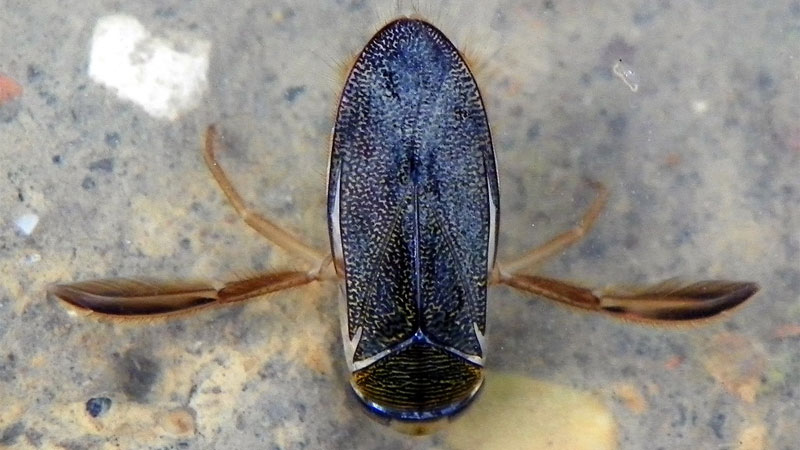
There are over 500 species of water boatman (not to mention other bugs with similar names). They range in size from 0.1 to 0.6 inches long and get their name from the hairs on their legs which make the legs resemble oars. Most water boatman bugs hunt insects, but some species feed on algae and aquatic plants.
These little bugs aren’t a health risk and can even be beneficial. However, you don’t want them hanging around in your pool because they can attract lizards and other predators.
#10 – Water Mites (Hyporder Hydrachnidia)
Water mites are a group of aquatic mites we’re still learning a lot about. There are currently 6,000 known species, most of which are a bright red to orange color, although there are blue, green, and yellow species out there.
In their larval phase, water mites are generally parasitic, infesting the aquatic stages of mosquitoes, flies, and many other insects. Most adults feed on algae, insects, or even other water mites. Often, the prey for both adults and larvae are the same.
Water mites are incredibly small and pose no threat to humans. However, they’re fast breeders, meaning your pool can soon become overwhelmed. Additionally, the presence of pool mites is an indicator that you have other insect issues in your pool to worry about.
#11 – Water Striders (Family Gerridae)
There are more than 1,700 species of these peculiar insects in the world, and some might even find their way into your pool. Most are less than 1/2 inch long, but a few species can grow to nearly an inch.
Thankfully, the largest species, Gigantometra gigas, is only found in parts of Vietnam and Southern China, where it can grow to an impressive 1.4 inches long.
However, what makes these bugs famous is their ability to walk on water. They have long, thin legs that allow them to stand on the water’s surface without breaking surface tension. The legs are flexible enough that they can redistribute weights needed to ensure the water strider keeps perfect balance.
Water striders actively hunt spiders and insects, so finding them in your pool is both a sign that you’re getting some cleanup assistance and a warning that you may have an infestation of thrips or some other tiny bug in your pool.
- How to Get Rid of Hawks - March 8, 2024
- How to Get Rid of Pill Bugs (Rolly Pollies) - March 1, 2024
- How to Get Rid of Groundhogs (Woodchucks) - February 5, 2024

